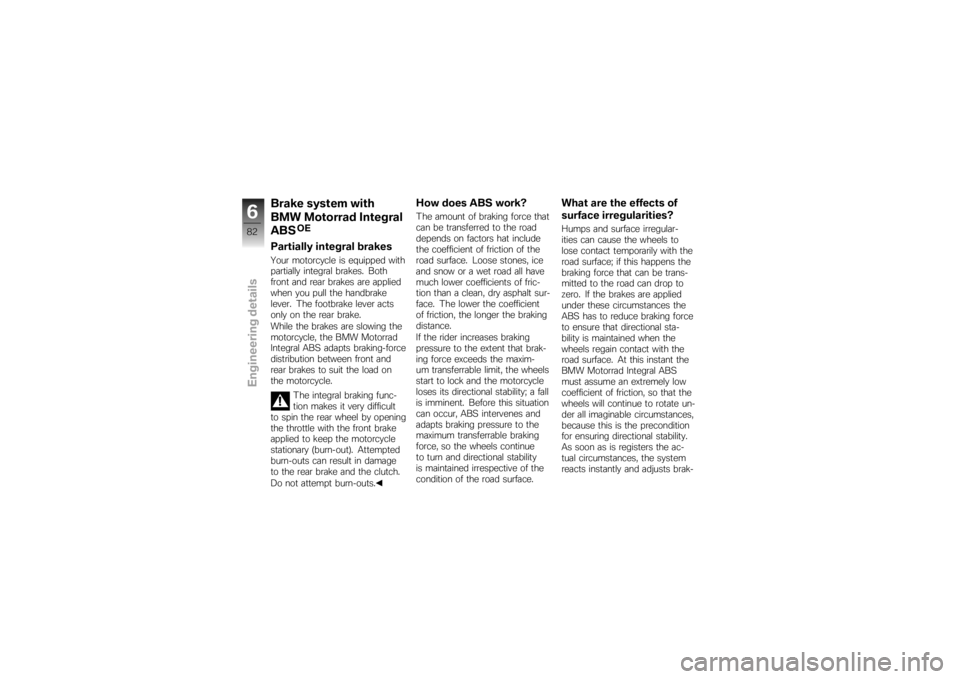Page 84 of 168

Brake system with
BMW Motorrad Integral
ABS
OE
Partially integral brakesYour motorcycle is equipped with
partially integral brakes. Both
front and rear brakes are applied
when you pull the handbrake
lever. The footbrake lever acts
only on the rear brake.
While the brakes are slowing the
motorcycle, the BMW Motorrad
Integral ABS adapts braking-force
distribution between front and
rear brakes to suit the load on
the motorcycle.The integral braking func-
tion makes it very difficult
to spin the rear wheel by opening
the throttle with the front brake
applied to keep the motorcycle
stationary (burn-out). Attempted
burn-outs can result in damage
to the rear brake and the clutch.
Do not attempt burn-outs.
How does ABS work?The amount of braking force that
can be transferred to the road
depends on factors hat include
the coefficient of friction of the
road surface. Loose stones, ice
and snow or a wet road all have
much lower coefficients of fric-
tion than a clean, dry asphalt sur-
face. The lower the coefficient
of friction, the longer the braking
distance.
If the rider increases braking
pressure to the extent that brak-
ing force exceeds the maxim-
um transferrable limit, the wheels
start to lock and the motorcycle
loses its directional stability; a fall
is imminent. Before this situation
can occur, ABS intervenes and
adapts braking pressure to the
maximum transferrable braking
force, so the wheels continue
to turn and directional stability
is maintained irrespective of the
condition of the road surface.
What are the effects of
surface irregularities?Humps and surface irregular-
ities can cause the wheels to
lose contact temporarily with the
road surface; if this happens the
braking force that can be trans-
mitted to the road can drop to
zero. If the brakes are applied
under these circumstances the
ABS has to reduce braking force
to ensure that directional sta-
bility is maintained when the
wheels regain contact with the
road surface. At this instant the
BMW Motorrad Integral ABS
must assume an extremely low
coefficient of friction, so that the
wheels will continue to rotate un-
der all imaginable circumstances,
because this is the precondition
for ensuring directional stability.
As soon as is registers the ac-
tual circumstances, the system
reacts instantly and adjusts brak-
682zEngineering details
Page 88 of 168

If the front wheel lifts clear of the
ground under severe accelera-
tion, the ASC reduces engine
torque until the front wheel re-
gains contact with the ground.
Under these circumstances,
BMW Motorrad recommends
rolling the throttle slightly closed
so as to restore stability with the
least possible delay.
When riding on a slippery sur-
face, never snap the throttle
twistgrip fully closed without
pulling the clutch at the same
time. Engine braking torque can
cause the rear wheel to lock, with
a corresponding loss of stability.
The BWM Motorrad ASC is un-
able to control a situation of this
nature.
Tyre pressure
monitoring RDC
OE
FunctionA sensor integrated into each
tyre measures the air temperat-
ure and the air pressure inside
the tyre and transmits this in-
formation to the control unit.
Each sensor has a centrifugal-
force tripswitch that does not
enable transmission of the meas-
ured values until the motorcycle
has accelerated to about 30 km/
h. The display shows
--
for
each tyre until the tyre-pressure
signal is received for the first
time. The sensors continue to
transmit the measured-value sig-
nals for approximately 15 minutes
after the motorcycle comes to a
stop.
The control unit can adminis-
trate four sensors, so two dif-
ferent sets of wheels with RDC
sensors can be alternated on the motorcycle. An error mes-
sage is issued if wheels without
sensors are fitted to a motorcycle
equipped with an RDC control
unit.
Temperature
compensationThe tyre-pressure readings
shown by the multifunction
display are temperature-
compensated; the reference tyre
temperature for these readings
is always 20 °C. The air lines
available to the public in petrol
stations and motorway service
areas almost invariably show
temperature-dependent tyre
pressures, so in most instances
these gauge readings will not
tally with the readings shown by
the multifunction display.
686zEngineering details
Page 99 of 168
Maintenance
Maintenance
General instructions.................. 98
Toolkit ............................... 98
Engine oil ............................ 99
Brake system, general . . . .......... 101
Brake pads . . . ..................... 102
Brake fluid ......................... 103
Clutch ............................. 105
Tyres .............................. 106
Rims ............................... 107
Wheels ............................ 107
Front-wheel stand ................. 115
Rear-wheel stand .................. 116
Bulbs .............................. 118
Jump starting . ..................... 125
Battery ............................. 126
897zMaintenance
Page 107 of 168
Check the brake fluid level in
brake fluid reservoir1.
The brake fluid level in the
brake fluid reservoir drops
as the brake pads wear. Brake fluid level, rear
DOT4 brake fluid
Do not permit the brake fluid
level to drop below the MIN
mark. (Brake-fluid reservoir
horizontal)
If the brake fluid level drops be-
low the permitted level: Have the defect rectified as
quickly as possible by a spe-
cialist workshop, preferably
an authorised BMW Motorrad
dealer.
ClutchChecking clutch operationPull the clutch lever.
The pressure point must be
clearly perceptible.
If the pressure point is not clearly
perceptible:
Have the clutch checked by a
specialist workshop, preferably
an authorised BMW Motorrad
dealer.Checking clutch fluid levelMake sure the ground is level
and firm and hold the motor-
cycle upright.
with OA Centre stand:
Make sure the ground is level
and firm and place the motor-
cycle on its centre stand.
Move the handlebars to the
straight-ahead position.
8105zMaintenance
Page 108 of 168
Check the clutch fluid level in
clutch fluid reservoir1.
Wear of the clutch causes
the fluid level in the clutch
fluid reservoir to rise. Clutch fluid level
Do not permit the clutch flu-
id level to drop.
If the fluid level drops: Unsuitable hydraulic fluids
could cause damage to the
clutch system.
Do not attempt to top up the
system with fluids of any kind.
Have the defect rectified as
quickly as possible by a spe-
cialist workshop, preferably an authorised BMW Motorrad
dealer.
The clutch system is filled
with a special hydraulic
fluid that does not have to be
changed.
TyresMeasuring tread depth of
tyres
Your motorcycle's handling
and grip can be impaired
even before the tyres wear to
the minimum tyre tread depth
permitted by law.
Have the tyres changed in good
time before they wear to the
minimum permissible tread
depth.
Make sure the ground is level
and firm and place the motor-
cycle on its stand.
8106zMaintenance
Page 136 of 168

Remove stains of this kind im-
mediately, using cleaning-grade
benzene or petroleum spirit on a
clean cloth or ball of cotton wool.
BMW Motorrad recommends
BMW tar remover for removing
specks of tar. Remember to wax
the parts treated in this way.Protective wax coatingBMW Motorrad recommends
applying only BMW car wax or
products containing carnauba
wax or synthetic wax.
It is time to rewax the paint-
work when water "puddles" on
the surface, instead of forming
beads.Laying up motorcycleClean the motorcycle.
Remove the battery.
Spray the brake and clutch
lever pivots and the main andside stand pivots with a suit-
able lubricant.
Coat bright metal and chrome-
plated parts with an acid-free
grease (e.g. Vaseline).
Stand the motorcycle in a dry
room in such a way that there
is no load on either wheel.
Before laying the vehicle
up out of use, have the en-
gine oil and the oil filter element
changed by a specialist work-
shop, preferably an authorised
BMW Motorrad dealer. Com-
bine work for laying up/restoring
to use with a BMW service or
inspection.
Restoring motorcycle
to useRemove the protective wax
coating.
Clean the motorcycle.
Install a charged battery. Before starting: work through
the checklist.
9134zCare
Page 137 of 168
Technical data
Technical data
Troubleshooting chart . . ........... 136
Threaded fasteners ................ 137
Engine ............................. 139
Fuel . ............................... 140
Engine oil .......................... 140
Clutch ............................. 141
Transmission . ..................... 141
Rear-wheel drive ................... 142
Running gear . ..................... 142
Brakes ............................. 143
Wheels and tyres .................. 143
Electrics ........................... 146
Frame ............................. 147
Dimensions . . . ..................... 148
Weights ............................ 148 Riding specifications
............... 149
10135zTechnical data
Page 138 of 168
Troubleshooting chartEngine does not start at all or is difficult to start.Possible causeRemedyKill switch activated. Kill switch in operating position (run).
Side stand extended and gear engaged. Retract the side stand ( 72).
Gear engaged and clutch not disengaged Select neutral or pull clutch lever ( 72).
Clutch pulled when ignition was OFF Switch on the ignition, then pull the clutch lever.
No fuel in tank. Refuelling ( 79)
Battery not adequately charged. Charge the battery when connected ( 127)
10136zTechnical data